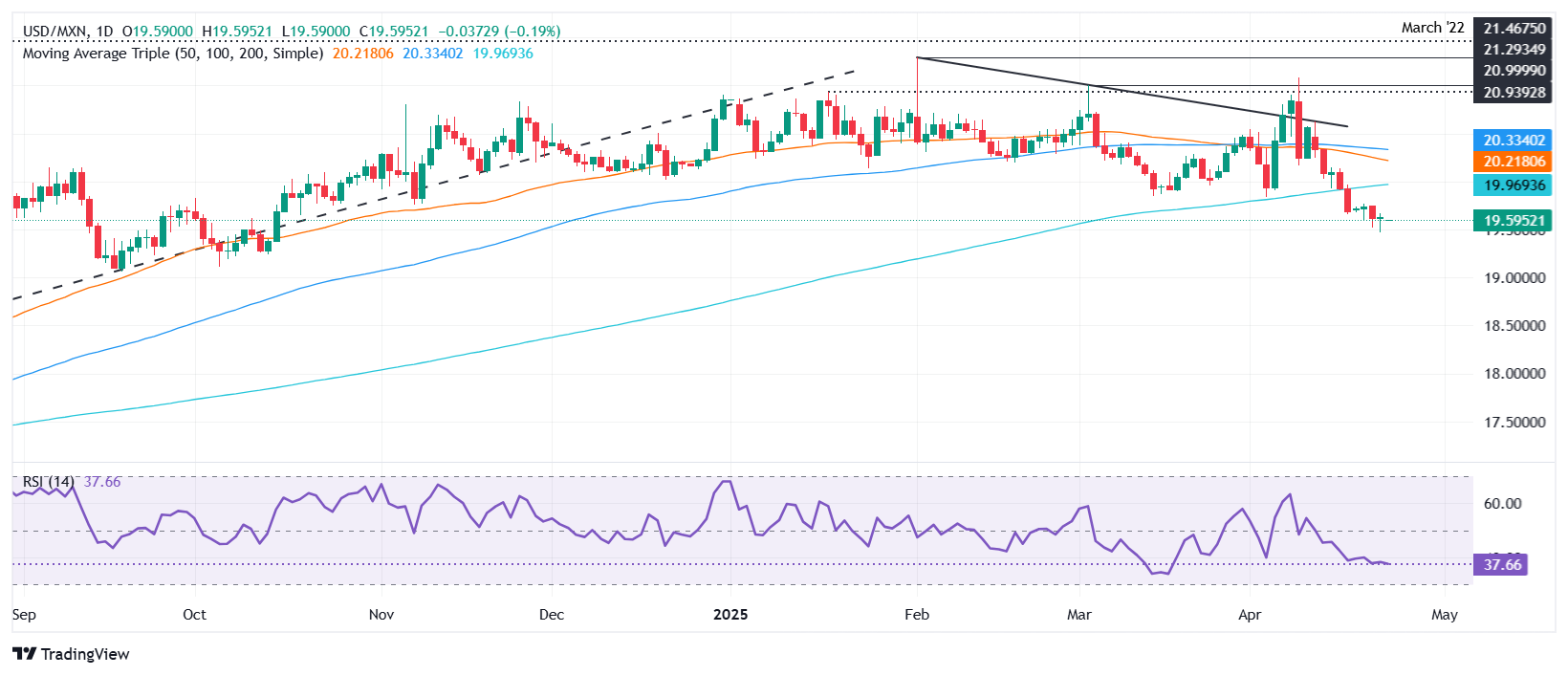Mexican Peso holds firm as inflation rises and US Dollar slides
- Mexican Peso appreciates as USD/MXN dips to 19.57, market prices in another 50 bps Banxico cut.
- Mexican inflation beats estimates but stays within Banxico’s target range.
- Citi survey shows most economists expect a 50 bps rate cut on May 15.
- Trump’s selective tariffs raise trade risks but spare Mexico—for now.
The Mexican Peso registered modest gains versus the US Dollar on Thursday due to the latter’s broad weakness, even though Mexico’s inflation came in slightly higher than expected. At the time of writing, the USD/MXN trades at 19.57 after hitting a daily high of 19.63.
Mexico’s annual inflation exceeded estimates in April, yet prices remained within Banco de Mexico’s (Banxico) 2% to 4% inflation range goal. Although prices ticked up, Banxico is projected to continue cutting rates by 50 basis points (bps) at the May meeting, which would be its third reduction of that size, following four straight 25 bps cuts since mid-2024.
In its latest Expectations Survey, Citi Mexico revealed that 36 economists polled expect the central bank will cut rates on May 15.
US President Donald Trump’s tariffs on Mexico's auto, steel and aluminum exports could further damage the country’s manufacturing base. However, some exporters were relieved that Trump had applied duties to most US trading partners but had kept Mexico off the list.
Mexican President Claudia Sheinbaum has said she wants to reach an agreement with Trump, but did not strike a deal in a phone call with him last week.
Ahead in Mexico’s economic docket, traders brace for the release of Economic Activity data.
Daily digest market movers: Mexican Peso unfazed by Banxico’s dovish stance
- The central bank divergence between Banxico and the Fed favors further upside in USD/MXN. Banxico’s Governing Council expressed its decision to continue easing the policy. Conversely, the Fed is considered cautious, as some officials have shown concerns about a reacceleration of inflation spurred by tariffs.
- Mexico’s Mid-month inflation in April accelerated by 3.96%YoY, above estimates of 3.78%. Core prices jumped from 3.56% to 3.90% YoY. Both figures remained within Banxico’s 3% goal plus or minus 1% range.
- Retail Sales in February were lower than expected, showcasing the ongoing economic slowdown, according to the Instituto Nacional de Estadistica Geografia e Informatica.
- Citi Mexico's expectations survey shows that economists expect Banxico to cut its rate by 50 basis points at the May meeting. For the full year, they project the main reference rate to end near 7.75%.
- Regarding the USD/MXN exchange rate, private analysts see the exotic pair finishing at 20.93, up from 20.90. Inflation in 2025 is projected to finish at 3.78% with core figures at 3.80% mostly aligned with the previous poll.
- Mexico’s economy is expected to grow 0.2% in 2025, below the 0.3% projected in the prior survey.
USD/MXN technical outlook: Mexican Peso remains bullish as USD/MXN stays below the 200-day SMA
The USD/MXN downtrend remains intact, but it seems that sellers are taking a breather. They failed to drag the exchange rate below April 23’s low of 19.46. A daily close below 19.50 could expose the current year-to-date (YTD) low, followed by the 19.00 psychological figure.
If buyers want to push prices higher, they must reclaim the 200-day SMA at 19.92, followed by the 20.00 figure. A breach of the latter will expose the confluence of the April 14 high and the 50-day SMA near 20.25-20.29 before testing the 100-day SMA at 20.33.

Mexican Peso FAQs
The Mexican Peso (MXN) is the most traded currency among its Latin American peers. Its value is broadly determined by the performance of the Mexican economy, the country’s central bank’s policy, the amount of foreign investment in the country and even the levels of remittances sent by Mexicans who live abroad, particularly in the United States. Geopolitical trends can also move MXN: for example, the process of nearshoring – or the decision by some firms to relocate manufacturing capacity and supply chains closer to their home countries – is also seen as a catalyst for the Mexican currency as the country is considered a key manufacturing hub in the American continent. Another catalyst for MXN is Oil prices as Mexico is a key exporter of the commodity.
The main objective of Mexico’s central bank, also known as Banxico, is to maintain inflation at low and stable levels (at or close to its target of 3%, the midpoint in a tolerance band of between 2% and 4%). To this end, the bank sets an appropriate level of interest rates. When inflation is too high, Banxico will attempt to tame it by raising interest rates, making it more expensive for households and businesses to borrow money, thus cooling demand and the overall economy. Higher interest rates are generally positive for the Mexican Peso (MXN) as they lead to higher yields, making the country a more attractive place for investors. On the contrary, lower interest rates tend to weaken MXN.
Macroeconomic data releases are key to assess the state of the economy and can have an impact on the Mexican Peso (MXN) valuation. A strong Mexican economy, based on high economic growth, low unemployment and high confidence is good for MXN. Not only does it attract more foreign investment but it may encourage the Bank of Mexico (Banxico) to increase interest rates, particularly if this strength comes together with elevated inflation. However, if economic data is weak, MXN is likely to depreciate.
As an emerging-market currency, the Mexican Peso (MXN) tends to strive during risk-on periods, or when investors perceive that broader market risks are low and thus are eager to engage with investments that carry a higher risk. Conversely, MXN tends to weaken at times of market turbulence or economic uncertainty as investors tend to sell higher-risk assets and flee to the more-stable safe havens.

